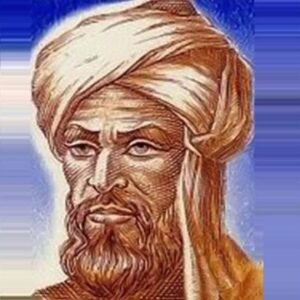Al-Khwarizmi was a Persian mathematician, astronomer, and geographer who flourished during the Abbasid Caliphate, the third Islamic caliphates to after Muhammad. His contribution to the subject of mathematics, particularly algebra, has been amazing as a scholar in Baghdad’s House of Wisdom. Scholars in Renaissance Europe regarded him as the originator of algebra, while it was later discovered that his work was based on older Indian or Greek sources. However, the fact that the word “Algebra” is derived from “al-jabr,” one of the two operations he utilized to solve quadratic equations, attests to his importance in the creation of this discipline of mathematics. He was noted for his methodical approach to solving linear and quadratic equations, and some of his work was based on Persian and Babylonian astronomy, Indian numerals, and Greek mathematics. He was also an expert in the subjects of astronomy and geography, in addition to mathematics. He also wrote on astrology and rectified and amended Ptolemy’s findings for Africa and the Middle East. A book on the Hebrew calendar, in which he recounts the 19-year intercalation cycle, is also among his writings.
Childhood and Adolescence
He was born in Chorasmia around 780 as Ab ‘Abdallah Muhammad ibn Ms al-Khwrizm to a Persian family. Due to a paucity of well-documented facts, nothing is known about his early life.
It is commonly assumed that he originated from Khwarezm (Khiva), then Greater Khorasan, based on his name. Other reports, however, say he may have originated in Qutrubbul (Qatrabbul), a vineyard zone near Baghdad.
Al-Khwarizmi lived under the Abbasid Caliphate and had a distinguished career at the court of Abbasid caliph al-Mamun. The caliph was fascinated by science and philosophy, and he pushed Al-Khwarizmi to pursue scholastic studies.
Many details about his work life are also unknown because he lived several centuries ago. He may have been affiliated with al-Baghdad Mamun’s scientific college, the House of Wisdom, according to certain sources (Arabic, Bayt al-Hikma).
During this time, he is thought to have participated in the calculation of the length of a degree of latitude. He was involved in a large project to establish the Earth’s circumference, after which he assisted in the creation of a global map for the caliph, supervising 70 geographers.
He was a talented mathematician whose 825 CE treatise ‘On the Calculation with Hindu Numerals’ was instrumental in spreading the Indian method of numeration throughout the Middle East and Europe. The work was then renamed ‘Algoritmi de number Indorum’ after its Latin translation.
In 830, he finished his mathematical book, ‘The Compendious Book on Calculation by Completion and Balancing’ (al-Kitab al-mukhtar fisb al-jabr wall-muqbala), in which he gave an extensive explanation of solving polynomial equations up to the second degree.
In the 12th century, the work was translated twice into Latin. It was a significant study in which solutions to several hundred basic quadratic problems were offered using both analytical and geometrical methods.
In his ‘Kitb rat al-Ar,’ which he completed in 833, he amended Ptolemy’s ‘Geography’ and corrected his data for Africa and the Middle East. He provided a list of 2402 cities and other geographical coordinates based on those in Ptolemy’s Geography, but with better values for the Mediterranean Sea, Asia, and Africa. Only one copy of ‘Kitb rat al-Ar’ survives today, and it is housed at the Strasbourg University Library.
He has made significant contributions to the field of trigonometry. He is credited with developing sine-function trigonometric tables, which were later used to help build tangent functions.
His contributions to mathematics included the development of the calculus of two errors, which led to the notion of differentiation.
He gave tables for the movements of the sun, moon, and five planets known at the time in his book ‘Astronomical tables of Sind and Hind.’ The publication, which included 37 chapters on calendrical and astronomical computations, 116 tables with calendrical, astronomical, and astrological data, and a table of sine values, ushered in a new era in Islamic astronomy.
Al-mathematical Khwarizmi’s contributions were so great that Renaissance European scholars believed he was the founder of algebra. He is credited with introducing the Arabic numerals to the Western world, which are based on the Hindu-Arabic numeral system created in Indian mathematics.
The terms “algorithm” and “algorism” are derived from the Latinized forms of Al-name, Khwarizmi’s ‘Algoritmi’ and ‘Algorismi’, respectively, indicating the significance of his contribution to mathematics.
His Major Projects
Al-Khwarizmi is most known for his comprehensive mathematics book, ‘The Compendious Book on Calculation by Completion and Balancing,’ in which he gives an in-depth explanation of calculating the positive roots of polynomial equations up to the second degree. The book also goes over the calculations that go into Islamic inheritance laws.
Personal History and Legacy
He died around the year 850.
Estimated Net worth
Unknown.


